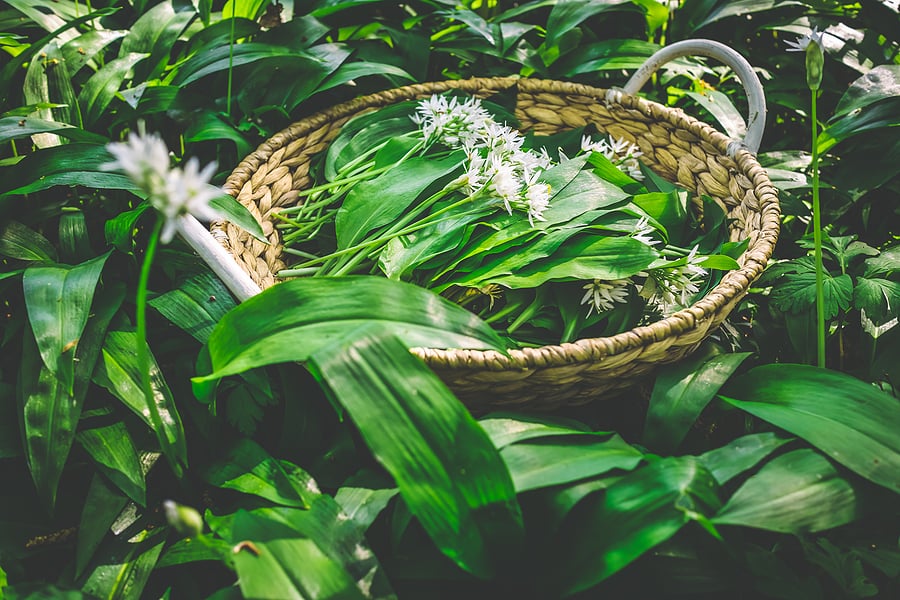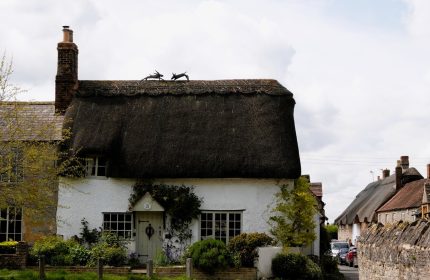Uses for Wild Garlic
Wild garlic, also known as Ramsons, is a popular springtime ingredient in the UK.
It can be found in woodlands, meadows and hedgerows from March to May. In this feature, we will explore some facts about wild garlic, and its uses, and we share a delicious recipe for wild garlic pesto.
Facts about Wild Garlic:
- Wild garlic is a member of the allium family, which includes onions, leeks and chives.
- It has a strong garlic scent and a mild, sweet flavour that is less pungent than regular garlic.
- The leaves of wild garlic can be eaten raw or cooked, and the flowers are also edible.
- The leaves of wild garlic contain high levels of vitamin C and other nutrients, making it a healthy addition to meals.
- Wild garlic is a popular ingredient in traditional British cuisine, and has been used for centuries in dishes such as soups, stews, and omelettes.

Wild garlic. Allium ursinum, known as wild garlic, ramsons, cowleekes, cows’s leek, cowleek, buckrams, broad-leaved garlic, wood garlic, bear leek, Eurasian wild garlic or bear’s garlic.
Uses for Wild Garlic:
- Add fresh wild garlic leaves to salads, sandwiches, and wraps for a garlicky twist.
- Use wild garlic in place of regular garlic in recipes to add a mild, sweet flavour.
- Cook wild garlic leaves in butter or oil to create a simple and delicious side dish.
- Add wild garlic to soups and stews to add depth of flavour.
- Make wild garlic pesto (recipe below) and serve with pasta, bread, or as a condiment.
Wild Garlic Pesto Recipe

Fresh homemade wild garlic pesto
Ingredients:
- 100g wild garlic leaves
- 50g pine nuts
- 50g grated parmesan cheese
- 150ml olive oil
- Salt and pepper, to taste
Instructions:
- Rinse the wild garlic leaves and dry them thoroughly.
- Toast the pine nuts in a dry frying pan over medium heat until golden brown.
- In a food processor, combine the wild garlic leaves, toasted pine nuts, and parmesan cheese. Pulse until the ingredients are finely chopped.
- While the food processor is running, slowly pour in the olive oil until the mixture becomes a smooth paste.
- Season with salt and pepper to taste.
- Serve the pesto with pasta, bread, or use as a condiment.
Wild garlic butter

Homemade wild garlic butter
Ingredients:
- 100g unsalted butter, at room temperature
- 20-25g wild garlic leaves, washed and finely chopped
- 1/2 teaspoon sea salt
- 1/4 teaspoon black pepper
- 1/2 teaspoon lemon juice (optional)
Instructions:
- In a mixing bowl, combine the unsalted butter, finely chopped wild garlic leaves, sea salt, and black pepper. Use a fork to mix everything together until well combined.
- Add the lemon juice (if using) and mix it in until evenly distributed.
- Take a piece of cling film and lay it flat on the countertop. Spoon the butter mixture onto the centre of the cling film in a long line.
- Roll the cling film around the butter mixture, twisting the ends to create a tight, sausage-like shape.
- Chill the garlic butter in the refrigerator for at least 30 minutes or until firm.
- To serve, slice the garlic butter into rounds and serve with fresh bread, crackers, or use it to enhance your favourite dishes.
Note: This can also be frozen.
Enjoy your delicious homemade wild garlic butter!
In conclusion, wild garlic is a versatile and healthy ingredient that adds a unique flavour to meals. Whether you use it in salads, soups, or pesto, it’s a great way to add a garlicky twist to your cooking. So, next time you’re out foraging, don’t forget to look out for wild garlic!
Have you ever used it in the kitchen? Do you have any growing in your garden?




















